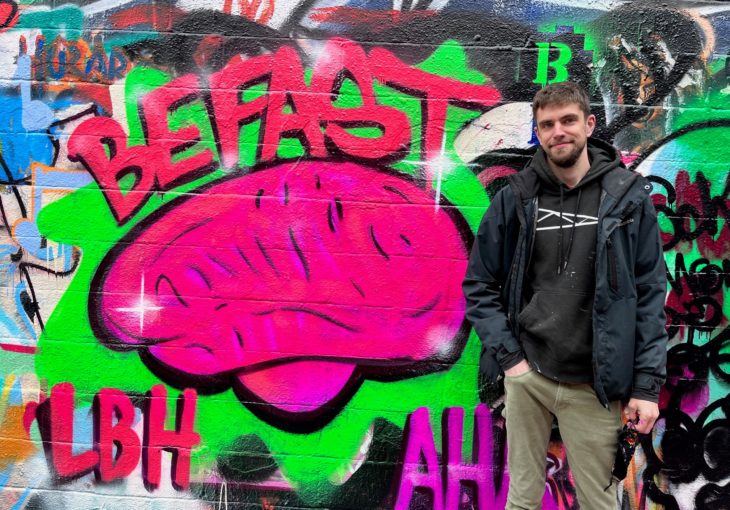Strokes can happen to anyone at any age. Globally, one in four adults over the age of 25 will have a stroke in their lifetime. Each year, approximately 800,000 people in the U.S. suffer a stroke. Most adults in the U.S. do not know the F.A.S.T. warning signs of a stroke, and that stroke is largely treatable if you call 911 as soon as you recognize the symptoms.
Baltimore County resident Carter Roach was among those that didn’t know much about stroke when he had one himself about 10 years ago. A street artist, Carter’s stroke caused his right hand to be paralyzed, forcing him to learn how to paint with his non-dominant left hand.
October 29 is World Stroke Day. The American Stroke Association, a division of the American Heart Association, a global force for healthier lives for all – is dedicated to saving people from stroke.
“Stroke remains the No. 2 killer in the world and can leave survivors with serious disabilities that can have a tremendous negative impact on their day-to-day lives,” says Dr. William Ashley, a neurosurgeon from LifeBridge Health and president of the American Heart Association’s Baltimore & Greater Maryland region board of directors.
On Friday, Oct. 28, the day before World Stroke Day, Carter will join Dr. Ashley and others from LifeBridge Health, and the American Stroke Association at Graffiti Alley in Baltimore to paint messages encouraging people to learn the F.A.S.T. warning signs and raise awareness.
Carter was listening to music on his phone, when he suddenly knew something was wrong. He looked at his phone and couldn’t read his playlist. He got up from his chair and his legs gave out. He couldn’t move the right side of his body. Lying face down on the floor, he managed to call his girlfriend for help.
“I tried to talk to her, but I couldn’t form words,” Carter recalled. “I would say an ‘A’ and it would come out a ‘B’.”
Carter was having a stroke and experiencing some of the classic symptoms — face drooping, arm numbness, speech difficultly, as well as sudden numbness or weakness in the legs, a loss of balance, trouble seeing and severe headache are all symptoms of a possible stroke.
His girlfriend called 9-1-1 and Carter was taken to the hospital, where he was diagnosed with infective endocarditis. Doctors told him a golf ball-sized clump of bacteria that had formed in his heart had broken off and traveled to his brain, causing the stroke.
Carter has since recovered, and while he has not experienced any additional issues with his heart or brain, the stroke caused his right hand to be paralyzed. A street artist, Carter had to teach himself to paint with his left hand after his stroke. After about a year of practice, he came to Graffiti Alley in Baltimore and painted his first full piece left-handed. Now a stay-at-home dad, Carter hopes his 20-month-old son can one day be inspired by him learning to paint again after his stroke.
“Stroke is a leading cause of preventable death, but lack of awareness, education and resources are major barriers to stopping it,” Dr. Ashley says. “Knowing the signs and symptoms of stroke, knowing how to respond when you recognize someone is having a stroke, and acting quickly can be the difference between life and death; between a strong recovery or a long-term disability.”
Learn how to spot a stroke F.A.S.T.:
- Face Dropping – Does one side off the face droop or is it numb? Ask the person to smile. Is the person’s smile uneven?
- Arm Weakness – Is one arm weak or numb? Ask the person to raise both arms. Does one arm drift downward?
- Speech Difficulty – Is speech slurred? Is the person unable to speak or hard to understand? Ask the person to repeat a simple sentence, like “The sky is blue.”
- Time to call 9-1-1 – If someone shows any of these symptoms, even if the symptoms go away, call 9-1-1 and get to a hospital immediately. Check the time so you’ll know when the first symptoms appeared.
“Fortunately, we have come a long way in our understanding of stroke and our ability to treat it, thanks in part to research and funding from the American Stroke Association, but there is no cure as good as prevention,” Dr. Ashley says. “Lifestyle changes such as exercising and moving more, eating healthier, managing your blood pressure and knowing your numbers can have a significant impact, lowering your risk of having a stroke.”
Some people have a higher stroke risk, like stroke survivors and people who have atrial fibrillation (AFib), but a stroke can happen to anyone at any point in their lifetime. Most strokes caused by AFib could have been prevented with effective treatment, but only about half of AFib patients receive proper therapy.
Knowing your numbers such as total cholesterol, blood pressure, blood sugar and body mass index can help reduce your risk, as well as knowing your family history of heart disease and stroke. The Association encourages you to learn these numbers and your family history, and then talk to your doctor about lowering your personal risk for stroke. In addition to checking your blood pressure and taking medication as prescribed, quit smoking and vaping, eat better, get healthy sleep and be active—these things not only help you avoid health problems issues later, but they also set a great example for those around you.
For more information, visit www.Stroke.org/WorldStrokeDay.
